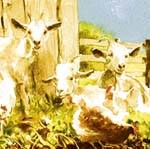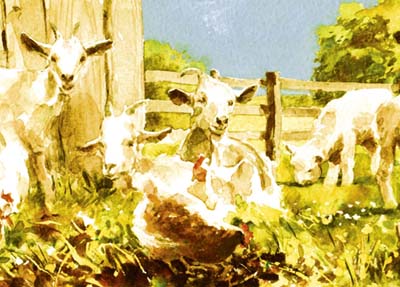Hobby Farming: top tips
Kate Green discovers the secrets of being a successful hobby farmer


The tranquil, serried lines of gleaming cattle, fluffy sheep, snoring pigs and exotic poultry at an agricultural show are enough to turn the head of any putative smallholder. But transport some of those attractive-looking breeds home to your modest acreage and the reality might be less idyllic: some sheep are unnervingly high-maintenance, pigs may persistently escape-remember the Tamworth Two?-and cows can be just too big and strong. Their produce may be overwhelming as well-if you want goats, for instance, the sensible way to start may be with only one milker plus a pygmy goat to keep it company.
‘The difference in approach is that large-scale producers are looking to breed from the best animals for the best end product, whereas a smallholder's animals are more part of the family,' advises Rupert Hartley Russell, owner of Bucklebury Farm Park in Berkshire. ‘For us, the right temperament is almost as important as the number of teats on a potential breeding sow.'
This is why the best hobby farmer's cow is a tame cow, which means one that has already been handled. ‘Looks can be deceiving,' points out Mr Hartley Russell. ‘We keep Dexter cattle, which are seen as small and cute and are regarded as a real smallholder's breed. But our experience is that they're not the most amenable of cattle-they can have strong characters. Our cross-bred Guernseys have sweeter, softer natures.'
Sheep may fulfil many duties: ornamental lawnmowers-primitive breeds such as Hebrideans, Portlands and Soays are good at this-providers of wool for spinning (for example, the striking Jacob) or meat for the freezer (such as the Southdown, Dorset Down, Oxford Down or Norfolk Horn).

However, sheep are also good at getting ill, and the Rare Breeds Survival Trust (RBST) doesn't recommend all rare breeds to new farmers the North Ronaldshay, for instance, is sensitive to copper in the land-nor long-wool breeds, which may be susceptible to skin complications.
Conservation officer Claire Barber says the trust usually promotes Downland breeds (most of which are now off the RBST watchlist). ‘They're more resilient and easier to handle. People may be put off by their bigger size, but I'm only 4ft 11in and I find them easy to shear.'
Similarly, white pigs are ‘out of the question' due to their susceptibility to sunburn, according to Liz Shankland, author of Haynes Smallholding Manual and a lecturer on pig-keeping at Kate Humble's farming enterprise in Monmouthshire. ‘Most smallholders want pigs to live outside all year round, so you need to look at longer-haired breeds such as the Berkshire or Tamworth. The Large Black is more of a grazer than a rooter and the Oxford Sandy & Black has become popular. They're pretty, docile and good dual-purpose [pork and bacon] pigs that you can keep longer without them running to fat.'
Exquisite houses, the beauty of Nature, and how to get the most from your life, straight to your inbox.
Mrs Shankland, who produced the champion Tamworth at the Royal Bath and West, dispels one porcine myth: ‘People say you should go for lop-eared breeds because they won't run anywhere due to their vision being blocked, but that's nonsense. I started with Tamworths and wild-boar crosses, both of which have sticking-up ears and were the most amiable of pigs-it's all in the handling. I like a pig with personality, and Tamworths talk to you.'
Mr Hartley Russell suggests that traditional breeds are best suited to a small-scale operation. ‘We had a brief foray into Man-galitza pigs and, with their curly coats, they were initially an attraction, but, being lard pigs, they aren't easy to produce well. We've moved into Berkshires, which are a smaller, old-fashioned native breed and the sows make good mothers. They still need care so that they don't run to fat in the final stages, but they're more inquisitive and friendlier than the Mangalitzas.'
The same principles apply to poultry. The top tip from Liz Wright, editor of Small-holder magazine, is to have hybrid hens. ‘People are sniffy about them, but all breeds of chicken are manmade. Hybrids start laying from about 14 weeks, as long as you feed them properly-and that doesn't mean kitchen scraps. Former battery hens are rewarding, but please get them from a charity.' (Try the British Hen Welfare Trust: 01769 580310; www.bhwt.org.uk)
Dr Barber agrees that some rare breeds carry too many pitfalls for the average hobby farmer. She recommends the Light Sussex, its rarer relation the Speckled Sussex-‘they're good for children, as they're cuddly; mine will just flop on the lawn'-and the Ixworth: ‘The boys make good meat and, in recent research, the girls came second in laying only to the Light Sussex, producing an average of 0.7 eggs per day.'
The key to hobby-farming happiness is to think small, certainly at first. ‘The most important thing is not what animals you get, but how many. Ten sheep on an acre is too many and if you run out of grass in the first year, you'll have trouble getting it back,' says Mrs Wright. ‘And it's important to find out if you actually like keeping animals before you get landed with a litter of piglets or multiple births of lambs. I think smallholding is a hard thing to combine with full-time work and commuting, which is probably why trends have changed. Not so many people see themselves as being self-sufficient, and it's become more of a hobby with a pay-off.'
Country Life is unlike any other magazine: the only glossy weekly on the newsstand and the only magazine that has been guest-edited by His Majesty The King not once, but twice. It is a celebration of modern rural life and all its diverse joys and pleasures — that was first published in Queen Victoria's Diamond Jubilee year. Our eclectic mixture of witty and informative content — from the most up-to-date property news and commentary and a coveted glimpse inside some of the UK's best houses and gardens, to gardening, the arts and interior design, written by experts in their field — still cannot be found in print or online, anywhere else.
